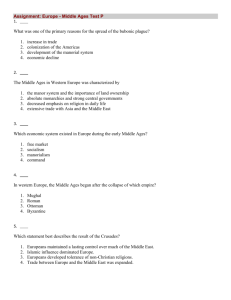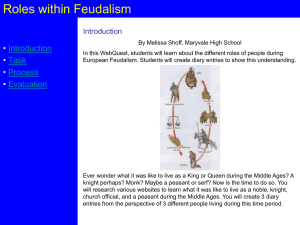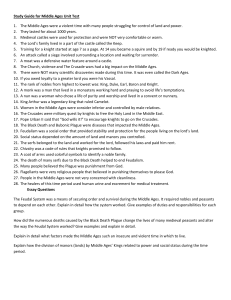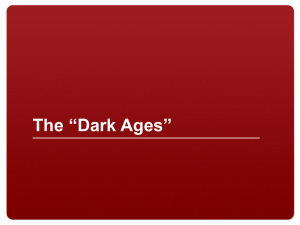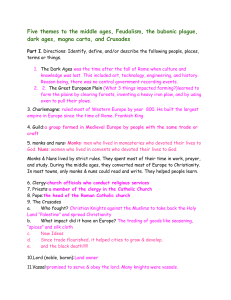Tristen and Isolde (up to 50 points)
advertisement
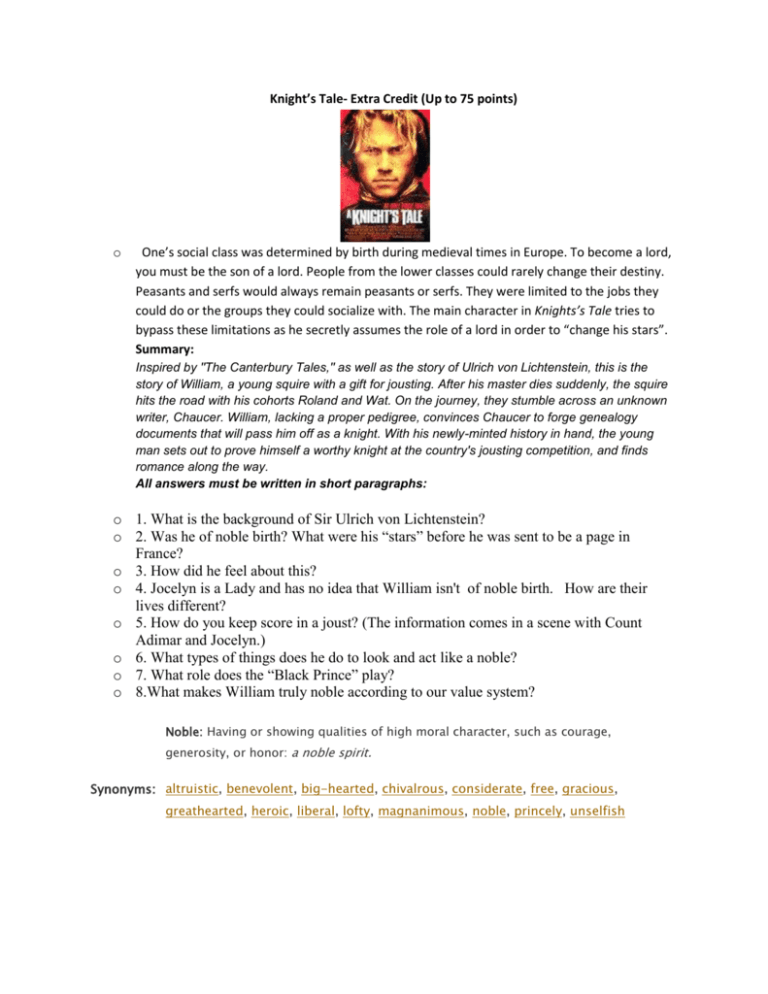
Knight’s Tale- Extra Credit (Up to 75 points) o One’s social class was determined by birth during medieval times in Europe. To become a lord, you must be the son of a lord. People from the lower classes could rarely change their destiny. Peasants and serfs would always remain peasants or serfs. They were limited to the jobs they could do or the groups they could socialize with. The main character in Knights’s Tale tries to bypass these limitations as he secretly assumes the role of a lord in order to “change his stars”. Summary: Inspired by "The Canterbury Tales," as well as the story of Ulrich von Lichtenstein, this is the story of William, a young squire with a gift for jousting. After his master dies suddenly, the squire hits the road with his cohorts Roland and Wat. On the journey, they stumble across an unknown writer, Chaucer. William, lacking a proper pedigree, convinces Chaucer to forge genealogy documents that will pass him off as a knight. With his newly-minted history in hand, the young man sets out to prove himself a worthy knight at the country's jousting competition, and finds romance along the way. All answers must be written in short paragraphs: o 1. What is the background of Sir Ulrich von Lichtenstein? o 2. Was he of noble birth? What were his “stars” before he was sent to be a page in France? o 3. How did he feel about this? o 4. Jocelyn is a Lady and has no idea that William isn't of noble birth. How are their lives different? o 5. How do you keep score in a joust? (The information comes in a scene with Count Adimar and Jocelyn.) o 6. What types of things does he do to look and act like a noble? o 7. What role does the “Black Prince” play? o 8.What makes William truly noble according to our value system? Noble: Having or showing qualities of high moral character, such as courage, generosity, or honor: a noble spirit. Synonyms: altruistic, benevolent, big-hearted, chivalrous, considerate, free, gracious, greathearted, heroic, liberal, lofty, magnanimous, noble, princely, unselfish Tristen and Isolde (up to 50 points) (After the Fall of Rome and during the rise of Feudalism) You must have your parent’s approval to do this activity. (The film is Rated PG-13 for intense battle sequences and some sexuality.) Step One: Read my brief introduction to the film. Step Two. Read through the topics you will be writing on and take notes on things that will help you answer the questions as you watch the movie. Pay careful attention during the first 10 minutes and be sure to turn on the subtitles! Ireland Britannia Introduction ”Who would be king?” “The strongest among us.” Europe in the Dark Ages; The Age of Warrior Kings. The period we call the “Middle Ages” is actually a period of over 800 years. We break it up into 3 time periods. Dark Ages or “Early Middle Ages” High Middle Ages Late Middle Ages 500 C.E.-------------------------------------------------------------1000C.E. ---------------------1300’s (When Feudalism began to evolve We have very little evidence For this time period.) When Feudalism was in high gear. When Feudalism started to break apart. The movie takes place in Britain during the 7th century(Dark Ages). Aragon (Tristen’s father) is trying to unite the “divided and weak tribes” of Britannia and get them to sign a Treaty of Unification. The leaders (the barons) present at the meeting represent the Pict, Celts, Angles and Saxon tribes. The Irish king Donnachadh was able to defeat each tribe when they fought independently. However, they believed that they could defeat his oppressive rulership if they rose up and fought together. Across the Irish Channel, lives Tristen’s family. Her father is the ruthless King Donnachadh. He gives her in marriage to one of his best warriors, Morhalt. Morhalt and Lord Badkin return to Britannia to take hostages and slaves from the British tribes. It is here that Tristen fights against Morhalt and is poisoned . EXTRA CREDIT (Up to 100 points) March 24th- May 2nd Enjoy The Getty: See the Real Thing Up Close The Getty has 3 exhibits that relate to our class. The Admission is free but you have to make reservations. Talk to your parents and see what they think. I know I am planning on going to see the Aztec Codex(picto-graphs) up close. We will be looking at Leonardo’s work toward the end of the year. He was an amazing artist and inventor. Order your free tickets on line. Write up a 2 page summary of what you saw and what was most interesting. Tell me about any thing else of interest that you saw or did. The Aztec Pantheon and the Art of Empire March 24–July 5 The Getty Villa Exploring a defining moment of cultural encounter, this exhibition presents masterworks of Aztec art as well as the fabled Florentine Codex, which returns to the Americas for the first time in more than four centuries. The exhibition opens March 24—be the first to see it! Book your free tickets to the Getty Villa. Leonardo da Vinci and the Art of Sculpture: Inspiration and Invention March 23–June 20 The Getty Center This major international loan exhibition—the first display of works by Leonardo da Vinci in Los Angeles in decades—explores a little-known facet of Leonardo's talents: his activity in the field of sculpture. It showcases Leonardo's ambitious designs for huge equestrian sculpture projects that were never completed and presents works by artists who inspired Leonardo and were inspired by him. The exhibition is organized by the High Museum of Art, Atlanta, in association with the J. Paul Getty Museum. Opens March 23. Building the Medieval World: Architecture in Illuminated Manuscripts March 2–May 16 The Getty Center See how the built world of the Middle Ages and Renaissance—soaring cathedrals, grand palaces, half-timbered houses, even military tents—was represented in painted books. Presenting rarely seen pages from the Museum's collection of manuscripts, this exhibition explores how artists used architecture as both decoration and symbol. Opens March 2. o Email Ms. Collins if you plan on going. o Save your ticket stub to staple to your written portion. o Think about taking a friend from class. It is always more fun when you go together. 100 points: Enjoy the Original Renassiance Faire in San Dimas (About an hour’s drive). (This one is expensive!) Go early because the parking is horrible. Be sure to see the Joust. Be sure to check “Themed Weekends” before you purchase tickets. There are some themes that might be offensive for younger students. http://www.renfair.com/socal/about/themedWknd.php Email Ms Collins before you go so I she can give you advice on how to handle the crowds. Write up a 2 page paper telling me what you did and what you saw. The Original Renaissance Faire April 10 - May 23, 2010 Saturdays & Sundays 10:00 AM - 7:00 PM Location: Santa Fe Dam Recreation Area - Irwindale, CA Advance Tickets 2010 • Save 30% with Early Bird Special tickets for a limited time! Through April 1st, 2010. • Make a Difference! Support the charity Autism Speaks via a special Advance ticket purchase at Click n'Print Purchase Tickets for 2010 Click to buy now... or Click to learn more... Children: ages 5 through 12. Adults: ages 13+. Children under 5 are always Free. Gate price: Adults, $25.00; Children, $15.00
